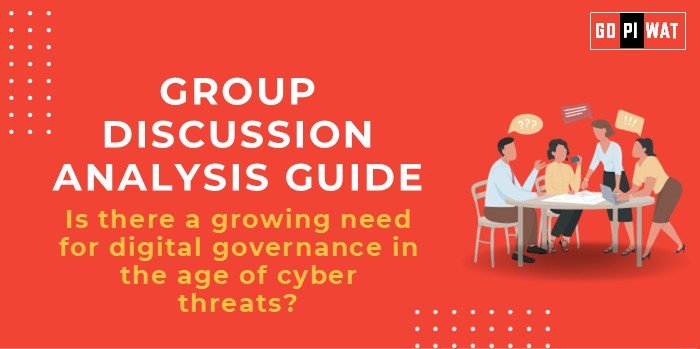📋 Group Discussion Analysis Guide
Topic: Is there a growing need for digital governance in the age of cyber threats?
🌐 Introduction
The rapid expansion of India’s digital economy, projected to contribute 20% of the national GDP by 2025, brings both opportunities and challenges. While initiatives like UPI dominate global digital payment systems, the rising cybersecurity incidents—1.59 million in 2023—highlight vulnerabilities requiring urgent attention. The need for robust digital governance has never been more critical in ensuring secure and inclusive growth.
📊 Quick Facts & Key Statistics
- ⚠️ Cybersecurity Incidents: 1.59 million cases in 2023, a 14.5% rise from 2022.
- 🏦 UPI Transactions: Facilitates over 75% of retail digital payments as of October 2023.
- 📈 Digital Economy Contribution: Estimated to account for 20% of GDP by 2025.
- 🌐 Rural Internet Connectivity: 37% of rural households have internet access (2023).
👥 Stakeholders and Their Roles
- Government: Strengthening cybersecurity policies and infrastructure (e.g., National Cybersecurity Policy).
- Private Sector: Innovating solutions to secure data and enhancing the digital user experience.
- Citizens: Practicing cyber hygiene and reporting vulnerabilities.
- Global Organizations: Driving international cooperation to combat cross-border cyber threats.
🏆 Achievements and Challenges
✔️ Achievements
- 🏦 UPI Leadership: UPI processes over 75% of retail payments, showcasing India’s fintech dominance.
- 📈 Digital Economy Growth: Projected contribution of 20% to GDP highlights its transformative potential.
- 🌐 Improved Connectivity: Rural internet access increased to 37%, reflecting steady progress.
⚠️ Challenges
- ⚡ Rising Cyber Incidents: A 14.5% increase in cybersecurity threats from the previous year.
- 📉 Digital Divide: Significant disparities remain despite progress in rural connectivity.
- 🌍 Global Benchmarks: India lags behind leaders like Estonia in cybersecurity maturity.
✨ Effective Discussion Approaches
💡 Opening Techniques
- 📊 Data Impact: “India’s digital economy is growing rapidly, yet cybersecurity incidents rose by 14.5% in 2023.”
- ⚖️ Contrast: “While UPI handles 75% of digital retail payments, rural internet access is still at 37%.”
💬 Counter-Argument Handling
- ✔️ “Although cybersecurity threats are rising, India’s investments in AI-driven threat detection show potential for improvement.”
- 🌐 “Progress in rural internet connectivity demonstrates gradual but significant success.”
🔍 Strategic Analysis of Strengths & Weaknesses
- Strengths: Global leadership in digital payments (UPI); significant digital economy contribution.
- Weaknesses: Cybersecurity vulnerabilities; persistent digital divide.
- Opportunities: Leveraging AI for threat mitigation; expanding BharatNet to underserved areas.
- Threats: Increasing sophistication of cyber threats; dependence on external technology for digital infrastructure.
📌 Structured Arguments for Discussion
- ✔️ Supporting Stance: “Digital governance is crucial to securing the 20% GDP contribution projected from India’s digital economy by 2025.”
- ❌ Opposing Stance: “Cybersecurity gaps and limited rural connectivity may undermine the benefits of digital governance.”
- ⚖️ Balanced Perspective: “While India’s digital initiatives are transformative, addressing cyber threats and the digital divide is essential for sustainable growth.”
🔗 Connecting with B-School Applications
- 🛠️ Real-World Applications: Exploring AI in cybersecurity; analyzing risks in digital payment ecosystems.
- 📄 Sample Interview Questions:
- “What are the key challenges in implementing secure digital governance?”
- “How can India emulate global digital governance best practices like Estonia’s model?”
- 📘 Insights for Students: Leverage India’s fintech success for project themes; study cybersecurity as a critical aspect of digital transformation.


